Punjabi Truckers on American Highways
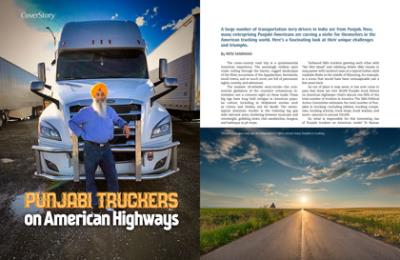
A large number of transportation lorry drivers in India are from Punjab. Now, many enterprising Punjabi Americans are carving a niche for themselves in the American trucking world. Here’s a fascinating look at their unique challenges and triumphs.
[Left] The lure of the open road, and the independence it offers, attracts many Punjabis to trucking.
The cross-country road trip is a quintessential American experience. The seemingly endless open roads cutting through the barren, rugged landscapes of the West, mountains of the Appalachian, farmlands, small towns, and so much more, are full of panoramic sights, novelty, and adventure.
The massive 18-wheeler semi-trucks—the commercial gladiators of the country’s voluminous interstates— are a common sight on these roads. These big rigs have long held intrigue in American popular culture, including in Hollywood movies such as Convoy and Smokey and the Bandit. The stereo- typical American trucker is the towering big guy with tattooed arms, bordering between muscular and overweight, gobbling down club sandwiches, burgers, and barbeque at pit stops.
Turbaned Sikh truckers greeting each other with “Sat Shri Akaal” and relishing chicken tikka masala or saag-paneer with tandoori naan at a typical Indian-style roadside dhaba in the middle of Wyoming, for example, is a scene that would have been unimaginable just a few years back.
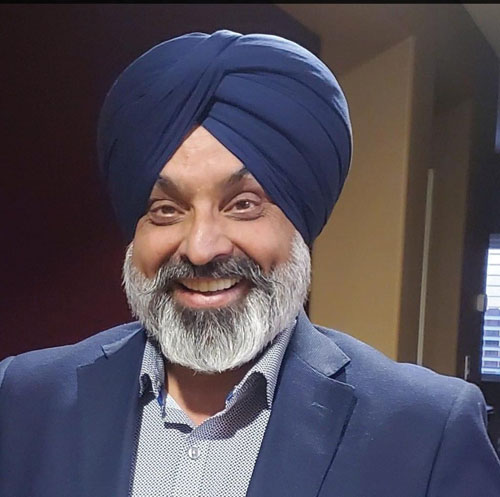
As out of place it may seem, it has now come to pass that there are over 30,000 Punjabi truck drivers on American highways—that’s almost one-fifth of the total number of truckers in America. The Sikh Political Action Committee estimates the total number of Punjabis in trucking—including jobbers, trucking companies, trucking schools, truck stops, truck washes, and more—amount to around 150,000.
[Right] Raman Dhillon, founder of The North American Punjabi Trucking Association (NAPTA)
So, what is responsible for this interesting rise of Punjabi truckers on American roads? To Raman Dhillon, founder of The North American Punjabi Trucking Association (NAPTA), this trend is not surprising, considering this community also dominates the trucking scene in India. “My father became a trucker at 16 years of age. I was driving a truck while in college in India. I started driving in the U.S. in 1996.” Dhillon also publishes Punjabi Trucking, a monthly magazine with a circulation of 10,000 copies and about 150,000 unique visitors per month on its website—a testament to the growing size of this segment.
The rise of Sikh immigrants in the U.S. in the late eighties and early nineties coincided with rapid attrition and turnover in the trucking industry in the U.S. due to changing regulations. Punjabis, with a long history of trucking in India, soon started filling this gap. “It is in our blood! It is the profession of choice for many of us because of the low barrier to entry and high pay,” says Dhillon.
Jitamber Singh Bedi, another trucker from California, shares a memory attesting how close trucking is to their hearts. Many years back, when he was new in the U.S., he had taken a Greyhound bus from New York City to San Francisco. “In Nebraska we were passing a truck. I looked at it, and a thought suddenly popped in my mind that someday I am going to be driving one of these. Sixteen years later I was driving an 18-wheeler on the same stretch of I-80, and I thought back to that Greyhound trip.”
Balvinder Singh Saini, who used to be a trucker for many years, and now operates a dhaba off I-5 in Bakersfield, California, offers his opinion on why his community gravitates towards trucking in the U.S., “Punjabis are warriors by nature. They are independent in their thinking and prefer to have their own businesses. Limited education and lack of fluency in the English language leaves some with few career choices. In trucking, they can make good money, be independent, and hope to own a large trucking business one day.It is an easy industry for them to understand as others before them can show them the way. If someone they know is in the business, they follow suit.”
[Bottom] Jitamber Singh Bedi had been dreaming of trucking since he moved to the U.S.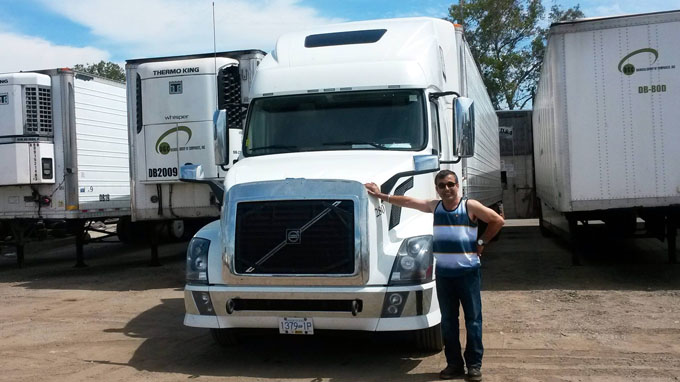
Interestingly though, not all Punjabi truckers fit into the mold described by Saini. There are many highly educated and qualified outliers who are drawn to trucking. Raja Sekhon, an ex-Indian Air Force officer and graduate of India’s National Defense Academy who has logged almost 500,000 miles on American highways as a long-haul trucker, says “Driving is therapeutic. I like the silence. I am in my cocoon. I don’t have to talk to people. I enjoy my company. My children are grown up. If I had young children I would have liked to be with them but at this stage of my life, I like being with myself,” he says about the experience of being on the road for hours at a stretch.
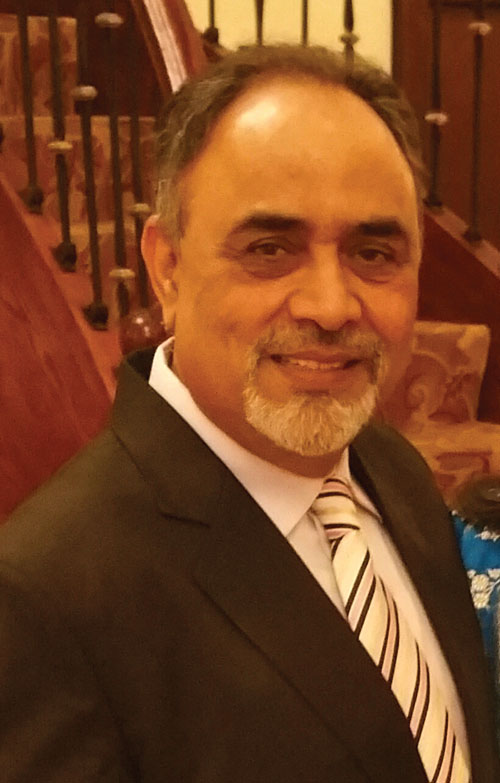
Just when you think it is a man’s domain, you have women like Gurjeet Kaur Randhwa helming these giant machines. A former national-level field-hockey player in India and a gold medalist in Physical Education, she was a Professor at Women’s College, Amritsar before moving to the United States. She now deftly navigates the big rig across Central Valley, California, carrying fresh produce to dinner tables across the country.
[Left] Raja Sekhon, an ex-Indian Air Force officer and graduate of India’s National Defense Academy who has logged almost 500,000 miles on American highways as a long-haul trucker, says “Driving is therapeutic.”
[Right bottom] Gurjeet Kaur Randhwa, a former national-level field-hockey player in India and a gold medalist in Physical Education, was a Professor at Women’s College, Amritsar. She now deftly navigates the big rig across America, driving close to 200,000 miles per year, when teamed up with her husband.
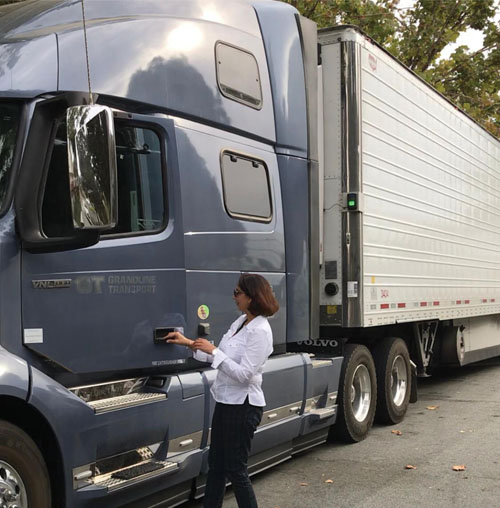
Speaking about why she got into trucking Randhwa says, “Money attracted me to truck driving. We were new to America. I had tried my hand at many things, ncluding being a lab technician. At the same time, I also wanted to be an entrepreneur for the independence it offered. But you need seed money to start a business. Meanwhile, my husband started earning a handsome income as a trucker. We realized that with an investment of about $30,000, we could start a trucking business and double our returns if we both drove together, taking turns and doubling the number of miles driven by the truck. This was the only way we could be independent business owners. All that was needed was hard work.”
Having now driven close to 200,000 miles per year through 35 states, Randhwa does not regret her decision. “Driving a truck boosts one’s confidence. If the person can manage such a beast, they have to be skilled. Besides, one is not a slave. We are in control of our time. We can stop and take a break whenever we want,” she says.
She also shares her joy on how trucking enables her to see America up close and personal. “Driving through small towns, I have seen the real America. Unlike tourists who see buildings, I have seen up close how people live.” And then there are the stunning landscapes and natural beauty that attracts her. Randhwa particularly likes Hwy 87 from Seattle to Spokane. “There are mountains on one side and the river stream on the other.” A particularly vivid memory that has been etched in her mind is when she was driing through a small town in Ohio, and at daybreak, “the early morning sunrise from behind the hills, filtering through the fog, was mesmerizing. It was magical!”
Dreaming of Dhabas
With Punjabi truckers crisscrossing the country, can Punjabi dhabas be far behind? That fond staple on Indian highways, a trusted haven for finger-licking good food and rest for tired lorry drivers. With offerings like butter chicken, daal makhani, naan, tall glasses of lassi and more, these establishments provide a satisfying and economic meal for the road-weary Indian truck drivers. It’s a welcome respite from an otherwise gritty and dangerous job, considering the high number of fatalities on Indian highways.

[Left] The emergence of dhabas on American highways falls right into the category of “Who would have thought?!” Indeed, it ranks right on top of the rapidly growing markers of the “Indianization” of America.
One can only imagine the joy experienced by a desi trucker in the U.S. as he pulls into a replica of the Indian dhaba right here on American interstates—complete with not only the aromatic and familiar food, but also with Punjabi music, turbaned staff, and greetings of “Sat Shri Akaal.” The emergence of dhabas on American highways falls right into the category of “Who would have thought?!” Indeed, it ranks right on top of the rapidly growing markers of the “Indianization” of America.
And yet it is not surprising, considering the growing number of Punjabi drivers that routinely drive up and down these interstates. A majority of Punjabi truckers are from Texas and California. I-40, which is the new alternative to the fabled American interstate Route 66, is the spine of the Sikh trucking world. A number of dhabas and full-service pit stops catering specifically to Punjabi drivers now line up the interstates in these regions. Interstate I-5 along with the western and midwestern parts of Interstate I-80 and I-10 are dotted with such establishments.
Truck Stop 40, the dhaba in Sayre, Oklahoma is one of the oldest establishments serving desi drivers. Besides the usual offerings of a gas station, convenience store, showers, and lounge; the Truck Stop 40, run by Harpreet Chhoker, also offers a 24-hour eatery and Gurudwara for worship.
Balvinder Singh Saini, a former trucker, operates a dhaba with his wife, Mansi Tiwari, and a small staff of relatives. At his location off I-5 in Bakersfield, California, tables have been set up outside and masked clients are seated six feet apart. There is ample parking space for truckers to pull in. Twelve dollars will buy four whole wheat rotis along with daal or a treat of lean goat meat curry. Creamy steaming chai is a given.
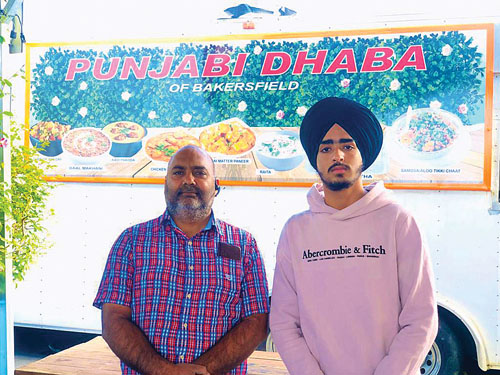
Saini’s dhaba feels like a piece of home. It has Punjabi music and movies on the wall-hung TVs. The ladies in the kitchen, much like aunts back in Punjab, wear Indian salwar trousers and kameez shirts, and share family gossip while they hand-roll rotis. Saini himself stops and chats with diners with tales of his own, watching indulgently as his customers devour their meals. “It is not just the body of the trucker, it is the spirit that gets nourished at these dhabas,” says Saini.
[Right] “It is not just the body of the trucker, it is the spirit that gets nourished at these dhabas,” says Balvinder Singh Saini, owner of Punjabi Dhaba food truck in Bakersfield, California
Incidentally, not all Punjabi truckers are fans of dhabas. Jitamber Singh Bedi thinks they are overpriced. Raja Sekhon has never eaten at a dhaba, as he prefers to pack home cooked food. Randhwa too prefers to pack nutritious food for herself. If she has to eat out, she prefers a salad or a veggie sandwich at Subway instead of dhaba. She says the dhabas are popular with young Punjabi drivers, many of whom are recent arrivals from India, because they get food they are familiar with even on American countryside.
Road Warriors: The Hazards of Being A Long-haul Truck Driver
As with most occupations, long haul trucking comes with its own set of formidable challenges. “When you are driving a vehicle that weighs 80,000 lbs, and which takes an entire football field length to come to a full stop, you really are riding a rocket. It is a powerful machine, and any small mistake can have magnified consequences,” explains Randhwa who routinely sees road accidents, some with fatalities.
A particularly traumatic experience was when she and her husband found themselves pulled into the nightmare of a fatal accident that unfolded right in front of their eyes. “We were driving to Spokane. At around 9:00 pm, a family with three young children passed us. The husband was driving. Suddenly, they were hit, head on, by a car driving the wrong way. Instantly, the cars exploded. I stepped hard on the brakes. We could see the children as the car caught fire. My husband immediately jumped out with the fire extinguisher to put out the fire. Meanwhile, I swerved the truck to block traffic. A lineup of trucks stopped behind us. Many other truckers also came running with their fire extinguishers. They put out the fire. But by that time, the father’s legs, which had been squashed inside the car, were completely burnt. He was screaming in pain. My husband and other truckers broke the window. I shone my high beams on the car as they pulled him out. The wife, in the front passenger seat, was dead. Thankfully, the children were pulled out, and later a helicopter airlifted the father to a hospital. A sobering incident for Randhwa, she recalls seeing the family as they passed by her truck. There was a child in a baby seat, and two little girls, both seemed younger than five years, alongside the baby.
Sekhon too has been in an accident. “At four in the morning, I was jolted from sleep and thrown around the truck. My co-driver had fallen asleep at the wheel and the truck had gone off the highway. Ambulances rushed to the scene. I tore my shoulder ligament, and my L-3 vertebrae broke.” Asked what he does to stay awake while driving, Sekhon says, “I like listening to old music. I don’t make calls on the phone. When I shut the music, I enjoy my own company and the nature around me.”
“This is a tough job. This occupation requires equanimity. If the driver gets distracted, it is dangerous. The driver must forget all their worries and stay calm at all times,” points out Randhwa somberly.
Not surprisingly, compliance requirements for truckers are rigorous to ensure safety for themselves as well as other drivers on the roads. The number of hours on the road is strongly regulated by the Department of Transportation (DOT). After being off duty for 10 or more consecutive hours, a trucker is allowed to drive for up to 11 hours in a period of 14 consecutive hours. The truck’s Electronic Logging Device (ELD) system makes a note of the number of hours the driver has been on the road. The driver must receive a minimum of 10 hours off duty if transporting property, and eight hours if transporting passengers.
The health stipulations for truckers are just as stringent. To maintain her truck driver’s license, Randhwa must ensure her blood pressure and diabetes is within the acceptable range. Gurjeet’s medical exam report is part of her driving record. It is filed electronically by the Medical Examiner (ME) with DOT bi-annually. Any drop in health indices would mean she loses her license or at best, gets recertified every year.
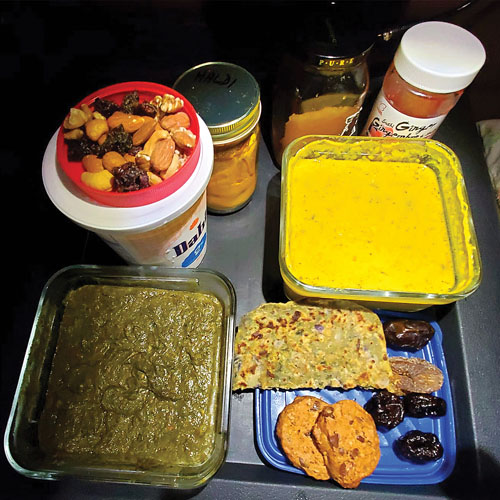
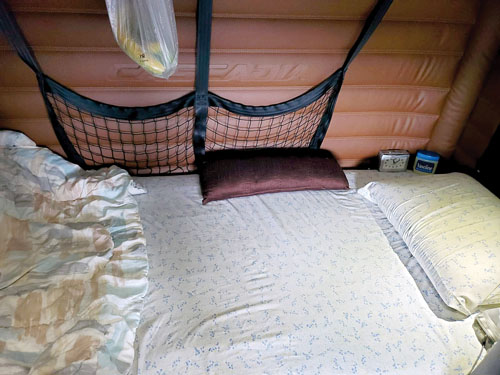
The looming threat of annual medical exams that can choke off their livelihood, puts pressure on truck drivers to manage the perils of their sedentary lifestyle that result from long hours of driving.
[Left] The health conscious Raja Sekhon packs nutritious home cooked food for his time on the road. A typical meal includes rotis made from spelt flour, daal, saag, and dahi. He also packs several herbal remedies and healthy snacks such as ginger, turmeric, honey, dry nuts, prunes, dates, figs, homemade gluten-free cookies, Metamucil, and plenty of warm water. [Right] Sekhon’s comfortable bed in his truck.
Long haul truck drivers in the U.S. have been found to have increased health risks and conditions such as obesity, diabetes, and cardiovascular risk factors. A pilot study on health and safety for truckers, published by the Journal of Occupational and Environmental Medicine, found that commercial truck drivers have a 50 percent higher risk of developing diabetes compared to the general population and that 87 percent of truck drivers have hypertension or prehypertension.
As a double whammy, South Asians have four to fivefold higher risk for Type 2 diabetes compared to other Asian migrant groups. This means South Asian truck drivers are particularly at high risk when it comes to illnesses that become more likely with sedentary jobs. “Sedentary lifestyle and erratic sleep get you if bad food on the road doesn’t,” says Jitamber Singh Bedi. “Sitting for ten hours a day for ten days at a stretch, the truck driver is a sitting duck for diseases like diabetes,” he says.
Irregular eating habits and dehydration further strain the system. As truckers are paid by the mile, every restroom stop costs precious time. Bedi is always worried about taking restroom breaks and therefore restricts the intake of much needed fluids to stay hydrated. This is a common practice and leads to more instances of voiding dysfunction, infertility, urolithiasis, bladder cancer, and urinary infections as compared to nonprofessional drivers as explained in a report from the Department of Urology, NYU Langone Medical Center.
Taking Health in Their Own Hands
Knowing the health risks stacked against them, the desi truckers are increasingly health conscious in their food choices while on the road. Randhwa's training in nutrition comes in handy as she plans for her time on the road. When driving her truck, she carries subzis or vegetable curries for her meals. She wraps the chapatis or flatbreads individually in airtight packs to keep them fresh longer. Every truck has a small rest area behind the driver’s seat. It holds a mini refrigerator, a microwave, and a bed to lay on.
When Raja Sekhon embarks on his five-day journey carrying a cargo of fresh produce across the U.S. and Canada, he packs his own food and avoids junk food as well as sodas. “From home I bring rotis made from spelt flour, daal, saag, and dahi. That’s my diet on the road.” Each day Sekhon also consumes ginger, turmeric, honey, dry nuts, prunes, dates, figs, homemade gluten-free cookies, Metamucil, and plenty of warm water.
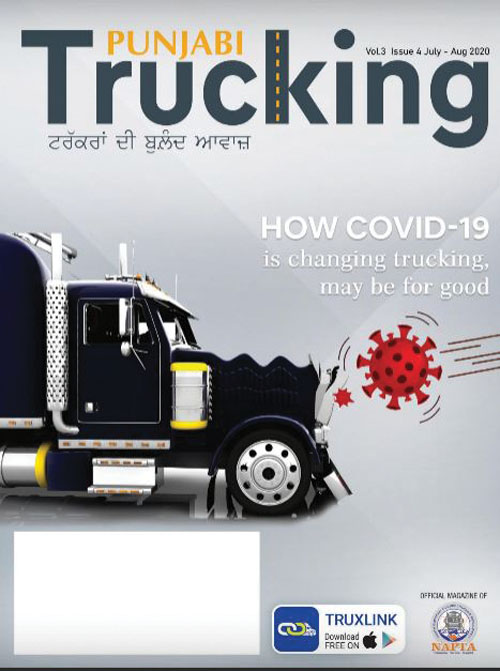
Randhwa is vegetarian when on the road and thinks that most Punjabi truck drivers too are largely vegetarian while driving. Sikhism, the religion of majority of Punjabi truck drivers, stipulates preference for a vegetarian diet. “Driving long hours, as we do, one definitely wants the blessings of the Guru with us,” says Randhwa. “It is harder to find vegetarian food on the road. We find long lines of truckers at Subway ordering a vegetarian sandwich.”
Unfortunately, being vegetarian further limits their food-stop choices on the road, so drivers pack nutritious meals before leaving home. On a ten to fifteen-day road journey, there always comes a time when drivers exhaust their stash of food and have to buy meals. This is where the driver must make informed choices.
[Right] Punjabi Trucking magazine has a circulation of 10,000 print copies and about 150,000 unique visitors on its website.
Fortunately, the dhabas now offer healthier choices. Saini, 44, was once a truck driver himself, but health problems forced him to find another way to support his family. “I make sure the food served to truckers is heart-healthy. The oil we use is cold press, the vegetables are non-GMO and organic, the flatbreads are made with whole wheat flour, and the food is portable. At times the truckers pick up forty flatbreads at the start of their journey,” says Saini. He adds, “We cook locally available seasonal vegetables. Sometimes this disappoints our clients, but we stay with a limited menu that is sourced locally.”
To counter the stiffness and lack of blood circulation on account of hours of nonstop seating while driving, the health-conscious Punjabi drivers are finding their own unique solutions to working out while on a long haul. Gurjeet prefers a walk at every stop, making sure to cover a few miles. As a female driver, security is a concern for her. So, she does not wander too far from the truck, but instead circles her 53-foot long truck, carving out her own track.
Sekhon too makes it a point to walk an hour each day that he drives. Besides, he also uses the stepping machine and dumbbells he carries in the truck. “You have to be fit to drive. If I don’t work out, I will be lethargic, out of shape, and accident prone. It is my responsibility to stay fit.”
As the ability to access and monitor healthcare on the road is crucial to the health of the Punjabi truckers, they increasingly use telemedicine to stay healthy on the road and meet their licensing requirements. The North American Punjabi Trucking Association (NAPTA) has negotiated a health plan for truckers that offers portability of insurance from one state to the other. This had so far been a bottleneck to seamless healthcare access. NAPTA wants to ensure that the truckers have access to pharmacy anywhere, and medication can be prescribed to the pharmacy closest to the driver. The new criteria allows the driver to video call his doctor from anywhere.
A Growing Force in theIndustry
As per an article in the LA Times, Sikh drivers are transforming U.S. trucking, “Over the last decade, Indian Americans have launched trucking schools, truck companies, truck washes, trucker temples, and no-frills Indian restaurants modeled after truck stops back home, where Sikhs from the state of Punjab dominate the industry.”
From the uneducated Punjabi truckers referenced by Balvinder Singh Saini, and well-educated and qualified ones like Gurjeet Kaur Randhwa and Raja Sekhon, to enterprising owners who run flourishing trucking companies with dozens of trucks; trucking in America attracts a panorama of profiles of Punjabis.
Dhillon’s association, NAPTA, has over 1100 members owning over 7000 trucks. Just like Gujarati Patels who started out in the hospitality industry as minions owning small mom and pop motels, and have now become influencers and leaders in the hospitality industry, Punjabis vested in trucking have come a long way in the industry.
Ritu Marwah, formerly a senior executive in Silicon Valley, is an award-winning writer whose story Jinnah’s Daughter, was featured in The New York Times’s Express Tribune blog.

__Dec_2020.jpg)
Following is a partial list of dhabas in the U.S.
- Punjabi Dhaba 2546 S Union Ave, Bakersfield, CA 93307
- Punjabi Truck Stop (I-40, exit 26) 11561 N 1900 Rd, Sayre, OK 73662
- Panjabi Dhaba Restaurant & Vega Truck Stop 3650, I-40, Vega, TX 79092
- Punjabi Dhaba 48243 Memorial Dr, Newberry Springs, CA 92365
- Taste of India 2405 NM-469, San Jon, NM 88434
- Dillon Truck Stop, 2405 State Highway 469, San Jon, NM (I-40, exit 356)
- Punjabi Dhaba 2650 N Roundup Ave, Kingman, AZ 86401
- Punjabi Dhaba 7311 Hwy 104 N, Cedar Grove, TN 38321
- Tandoori Indian Restaurant 12501 Valley View Rd, Shawnee, OK 74804
- Pilot Truck Stop, southside of Indy (I-495, exit 4)
- Spiceland Truck Plaza, 5809 IN-3, New Castle, IN 47385 (I-70, exit 123)
- Spicy Bite Indian Restaurant, (I-40, exit 79) 1203-1299 Motel Dr, Milan, NM 87021
- Demming Truck Plaza, 1310 W Spruce St, Demming, NM 88030 (I-10, exit 81)
- Punjabi Dhaba 7800 Batavia Rd, Dixon, CA 95620
- Speed Way Cafe I-80 exit, 4, Wendover, UT 84083
- Punjabi Dhaba 500 A Truck Inn Way, Fernley, NV 89408
- Jay Brothers Truck Stop Taste of India 74975 Rd, Overton, NE 68863
- Akal Travel Center 168 Hunt Rd, Laramie, WY 82070
- Akal Travel Center 915 Rd S, Waco, NE 68460 (Exit 360, off I-80)
- Antelope Truck Stop Pronghorn Indian & American Restaurant 4850 I-80 Service Rd, Burns, WY 82053-9808
Enjoyed reading Khabar magazine? Subscribe to Khabar and get a full digital copy of this Indian-American community magazine.
blog comments powered by Disqus










